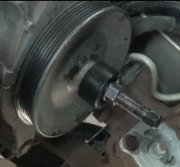The two nipples are pressed into the aluminum water pump housing, but that housing also holds the oil pump on the back side. As such, it is actually the front cover of the engine. The oil pump is driven by the snout of the crankshaft.
The top nipple, which is the one that corroded out on mine, connects to a hose that's about a foot long. It runs straight up to the thermostat housing. That nipple is screwed in and sits right behind a stiffening bracket. That bracket makes access a little difficult, but not impossible to get the hose and clamp off.
The nipple that comes out of the rear of the water pump housing connects to another hose about a foot long, but that one connects to a steel pipe that runs to the driver's side, then over the top of the transmission and to the back of the engine. I didn't follow it all the way, but I assume that is one of the heater hoses.
If you disconnect the AC compressor hoses, the compressor will never get turned on when you switch to "AC" or "defrost". There's a low-pressure cutout switch for this purpose. That prevents the compressor from potentially pumping the low side into a vacuum when the refrigerant has leaked out. If it were able to do that, air could get sucked in along with the deadly humidity in it. With the hoses disconnected, all that will happen is the compressor clutch will free-wheel like it normally does when it isn't turned on.
Once the lines are reconnected and you want to charge the system, it is necessary to pump it into a vacuum first for a good 30 - 45 minutes. In a near-perfect vacuum, water boils at 77 degrees. Turning to a vapor makes it easy to draw out. If any moisture remains in the system, it combines with refrigerant to form an acid that will corrode the condenser and evaporator.
Tuesday, August 20th, 2019 AT 5:05 PM


